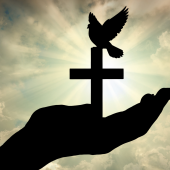The Ultimate Symbol of God's Mercy

April 8, 2025 Tuesday of the Fifth Week of Lent
Daily Readings: Numbers 21:4-9; John 8:21-30
The first reading offers profound insights into themes of faith, disobedience, repentance, and God's mercy. In the Gospel passage, Jesus speaks about His origin, mission, and identity. He declares that when He is lifted up, they will know that He is sent by the Father.
The Israelites are tired, weary, and impatient. As a result, they lose their faith in God and Moses and begin to complain. How about us? Do we not sometimes turn away from God and become impatient, even in the midst of His blessings? Despite their disobedience, God provides a way for them. The bronze snake on the pole becomes a symbol of God's mercy. It prefigures the cross of Christ. When we look up to Him in faith, we are sure to be healed. In moments of struggle and difficulty, do we grumble, or do we make an effort to face them with the strength of the Lord? Christ is the ultimate symbol of redemption and mercy.
The discourse between Jesus and the Pharisees calls us to recognize His relationship with the Father, asserting that He will do anything that pleases His Father. Are we able to align our lives with God's will?
It is interesting to observe that ambulances carry the image of a snake coiled around a staff. This symbolizes healing and medical care, stemming from Asclepius, the Greek god of medicine and healing. Also, the shedding skin of a serpent indicates renewal, rebirth, and rejuvenation. Through the snake, sin entered the world, and by looking at the snake on the staff, life was restored (Numbers 21:3). Now, whoever looks at the Cross of Christ will surely find life. Needless to say, the Cross of Christ is the ultimate demonstration of God's unconditional love.
Call to Action for Catholic Living:
- Turn to God in humility and seek His protection.
- Just as Moses stood between God and the Israelites, interceding on their behalf, let us bring the struggling and wandering people before Him, the Giver of life.
Radio Veritas Asia (RVA), a media platform of the Catholic Church, aims to share Christ. RVA started in 1969 as a continental Catholic radio station to serve Asian countries in their respective local language, thus earning the tag “the Voice of Asian Christianity.” Responding to the emerging context, RVA embraced media platforms to connect with the global Asian audience via its 21 language websites and various social media platforms.













